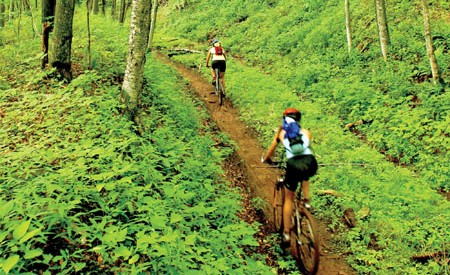West Virginia is celebrating its 150th anniversary as a state in 2013, and local conservationists are hoping to cap the sesquicentennial with a massive land protection bill. A coalition of organizations has proposed the creation of the Birthplace of Rivers National Monument, which would protect 123,000 acres of the southern Monongahela National Forest near Lewisburg. The swath of land includes the headwaters of six rivers (the Cranberry, Williams, Cherry, Greenbrier, Gauley, and Elk), as well as the the 48,000-acre Cranberry Wilderness, one of the wildest tracts of land in the South. Surrounding the Cranberry are the Cranberry Backcountry Area, Tea Creek Backcountry Area, and Turkey Mountain Backcountry, all of which would be included in the proposed monument.
All of the land within the proposal is already owned by the U.S. Forest Service, and managed primarily for recreation. A visitor’s center already exists, as does a scenic highway and trail infrastructure, making the monument a budget-friendly proposal that proponents hope will either gain congressional backing in the form of a bill or a signed declaration from President Obama. Backpackers and hikers love the Cranberry Wilderness, mountain bikers make pilgrimages to the Tea Creek Backcountry, and trout fishermen love it all, from the tight backcountry streams high on Gauley Mountain to the more accessible big water in the valleys. While the land is already owned and protected by the Forest Service, the monument proposal is an attempt to solidify the management plans currently in place, hedging bets against the whims of future political and commercial interests.
“It’s a complex of lands with super high quality recreation and ecological resources,” says Mike Costello, director of the West Virginia Wilderness Coalition, the organization spearheading the push for the new national monument. “These places mean a lot to West Virginia, but we’re facing an uncertain future for public lands. We look at the extreme members of Congress and see them trying to erode the protections that are currently in place in favor of more widespread commercial activity. Maybe next year, maybe in five years, the decision makers in government might decide to take a more extractive approach to forest management in West Virginia.”
The most immediate threat to the area is natural gas extraction by fracking. There are already fracking operations in the area as close as Richwood, a small town that would serve as a gateway community to the proposed monument. Establishing a national monument would give supporters peace of mind that the public minerals within the proposed boundaries would remain untouched and the recreation protected for future generations.
“The permanent nature of this proposal is exciting,” says Phillip Smith, chairman of West Virginia Trout Unlimited, which is helping shape the monument proposal. “It’s a legacy thing. Making sure that we have this core trout fishing area in perpetuity.”
According to Smith, the rivers within the proposed boundaries are some of the most pristine trout waters in the South. “It’s a fantastic area for native brook trout, every bit as good as Shenandoah or the Smokies. You can get a true backcountry experience. For the purist that loves the blue line backcountry water, it’s amazing.”
The mountain biking is as equally amazing. One of IMBA’s original epic rides, the Gauley Headwaters Ride, lies within the proposed boundaries, and Tea Creek Mountain Trail is regularly regarded as one of the most rugged, but beloved pieces of singletrack in the South. Because the biking and fishing in the area are so well regarded, Costello and the Wilderness Coalition are making a point to bring other organizations like Trout Unlimited and IMBA into the planning process.
“The proposal is as collaborative as it could possibly be,” Costello says. “IMBA and Trout Unlimited both had reservations about Wilderness designations we’ve proposed in the past because of trail access or stream restoration limitations. But they’ve come to the table for this proposal and helped define what the monument will and won’t be.”
Greg Moore, vice president of West Virginia Mountain Bike Association, has seen bike traffic drop dramatically in the area within the last decade, and thinks the national monument status could bring the bikers back. But Moore thinks monument proponents will have a tougher time convincing the local non-biking community that a national monument will be good for them.
“Most people around here are suspicious when the federal government wants to do something. People here are of the mindset that they’d rather just be left alone. They’d rather people not come here.”
Costello knows it will be an uphill battle gaining local support for the monument. There is no other land protection in West Virginia like the proposed monument, and the Birthplace of Rivers would be the first U.S. Forest Service-managed national monument in the East.
“There’s no gold standard of what a monument has to be. There’s no national monument act, like a Wilderness Act. So it’s a more flexible designation,” Costello says, adding that that flexibility makes it hard for people to comprehend. “The majority of opposition we’re seeing is a general anti-government, anti-public lands sentiment. It’s ironic, since we have a different fear of the government. We fear what the government will do with this land in the future if we don’t protect it.”








